610 Search Results for visual support
October 11, 2013
by Robin Parker -
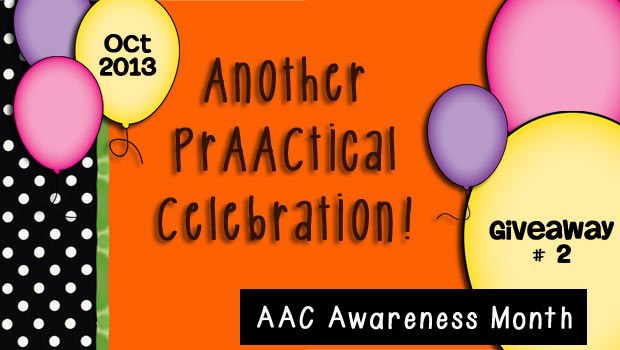
It’s time for the 2nd 2013 AAC Awareness Month celebration! It is so exciting to see all of the AAC activities and plans from around the country and world to help spread AAC Awareness. There has been sharing of AAC information, AAC decorations, Silent teas, and much more. We hope that with increased awareness, there is increased ACCESS for ALL who need it. Keep spreading AAC information and keep teaching & learning. HAPPY INTERNATIONAL AAC AWARENESS MONTH! Celebrate with us by entering our AAC giveaway. Good Luck Everyone! The PrAACtical AAC Celebration is made possible by the very generous and awesome people at the organizations listed below: : Ablenet, Inc Abilipad Alexicom BeeVisual/ChoiceWorks Dynavox/Mayer Johnson Handhold Adaptive Hump Software MarbleSoft Mozzaz News-2-You Paul H. Brookes Publishing Company Safe N Sound Mobile Silver Lining Multimedia Smarty Ears Speak For Yourself SpeechPathology.com SpeechTree TapSpeak TherapyBox/TBoxApps TouchChat Verbally How Does It Work?... [Read More...]
October 1, 2013
by Carole Zangari -

AAC Awareness Month is something worth celebrating. From the amazing clients we get to work with, to the professionals who put their hearts into this work, to the families who make real change possible, to the researchers and scholars who give us evidence on which to base our practices, to the wonderfully supportive community of manufacturers and developers, AAC is a wonderful field. It’s time for a prAACtical celebration! Thanks to the generosity of a lot of companies and individuals, we’re hosting our second annual AAC Awareness Month Giveaways with drawings on October 9th and 30th. As you can see, we’ve had prizes donated from many wonderful people and organizations: Ablenet, Inc Abilipad Alexicom BeeVisual/ChoiceWorks Dynavox/Mayer Johnson Handhold Adaptive Hump Software MarbleSoft Mozzaz News-2-You Paul H. Brookes Publishing Company Safe N Sound Mobile Silver Lining Multimedia Smarty Ears Speak For Yourself SpeechPathology.com SpeechTree TapSpeak TherapyBox/TBoxApps TouchChat Verbally How Does It... [Read More...]
August 21, 2013
by Robin Parker -

One of our wishes is that all of our students have educators like Think Inclusive’s– Tim Villegas. He has worked in special education and with people with disabilities for the past decade. He has been dedicated to talking and writing and talking about inclusion for everyone (and yes, everyone means everyone). We feel so lucky Tim is our guest blogger today. Read and learn about ‘essentials’ for assistive technology in the inclusive classroom. One of my favorite things to tell people when I discuss what kind of assistive technology (AT) to have for a particular student is to think about their strengths and build from there. In my first year of teaching students with significant cognitive and physical disabilities, one of my students was really good at pushing her foot out to make an affirmative response. So when looking at where to provide a switch or button for her to access…the natural choice... [Read More...]
August 3, 2013
by Carole Zangari -
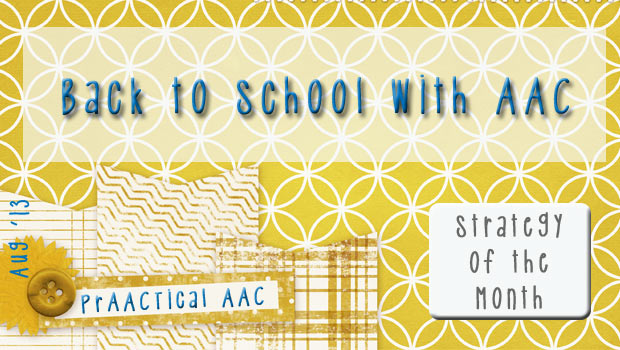
Here in the US, August is Back-to-School month. Throughout this month, we’ll try to post ideas and resources to help make the transition back to school a smooth and successful one. One of the most important things for students who use AAC is having their SLPs, teachers, and families on the same page. They each have a different but very intense relationship with the student’s AAC system. Here are some prAACtical thoughts on getting everyone on the same page. 1. Develop a communication profile of the student: In the initial weeks, try to get a baseline of how the student is communicating at the start of the year. For beginning communicators, we track things like their communicative intents (WHY they are communicating), modalities (HOW they are communicating), and the frequency of their communication. We’ve written about one of our favorite tools for this, the Communication Matrix. 2. Share what you know:... [Read More...]
July 20, 2013
by Robin Parker -
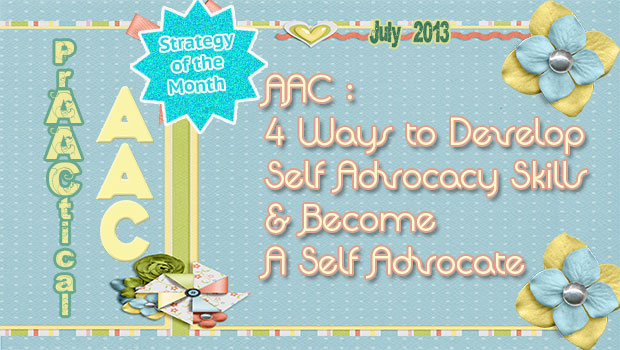
Self Advocacy comes in many shapes and forms for all learners. We all need to have a level of self advocacy skills to have a positive self-esteem, to continue a path of life long learning, and to defend and protect ourselves in situations that potentially can be harmful. The teaching of self advocacy begins with learning to request and protest but goes way beyond that for ALL learners. For those with AAC needs, specific strategies and direct instruction are often necessary to make self advocacy a comprehensive and robust skill. Self advocacy skills are a priority for older learners so for our Strategy of the Month, we will discuss some ways to help develop self advocacy skills beyond the requesting and protesting levels. We hope to build strong self advocacy skills for ALL learners. Rating Scales– Teach the use of rating scales to help AAC learners give their opinions on... [Read More...]
June 29, 2013
by Carole Zangari -
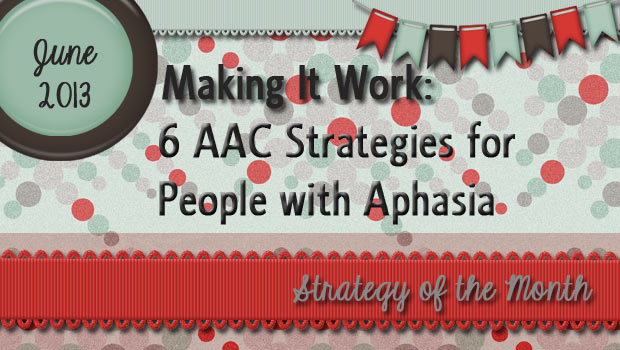
People with aphasia are often most successful when a number of different strategies are combined. In this post, we discuss a number of strategies that we can use in our therapy and teach to communication partners. Augmented Input We’ve written so many posts about aided language input that we’re almost embarrassed to bring it up again. Almost. It seems like no matter which age group or clinical population is the subject of our post, that strategy plays a central role. It is the same for people with aphasia with one exception. They benefit from a broader array of input cues, such as gestures, writing, and even pantomime. Augmented input is the term that is used to refer to oral language that is supplemented with pictures, print, gestures, pantomime, and the use of objects in the environment. By using these things as you speak, you enhance the ability of the person... [Read More...]
June 1, 2013
by Carole Zangari -
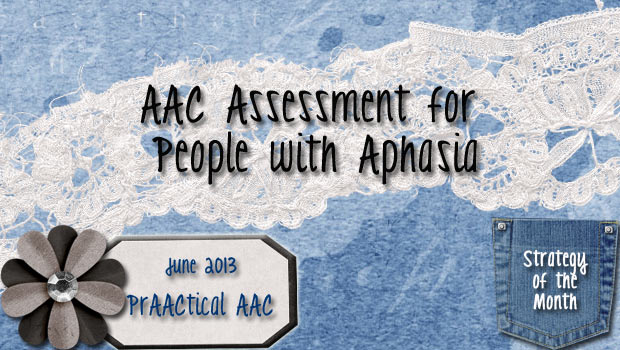
Many people with aphasia fail to regain sufficient speech and language skills to meet their communication needs. With more than one million people with aphasia in the US alone, chances are most people reading this know at least one person affected by the disorder. While many go on to regain functional speech and language skills, some remain unable to communicate well enough catch up with a neighbor, talk about bills with a spouse, ask a question in a store, play with a grandchild, or tell their healthcare providers about side effects or symptoms. It’s hard to really imagine how devastating and isolating this experience may be. Aphasia Awareness Month seemed like the perfect time to reach out to SLPs with information on AAC for people with aphasia. In this post, we’ll share some thoughts and resources on assessment. Assessment activities are, of course, driven by the purpose for which the... [Read More...]
May 20, 2013
by Carole Zangari -
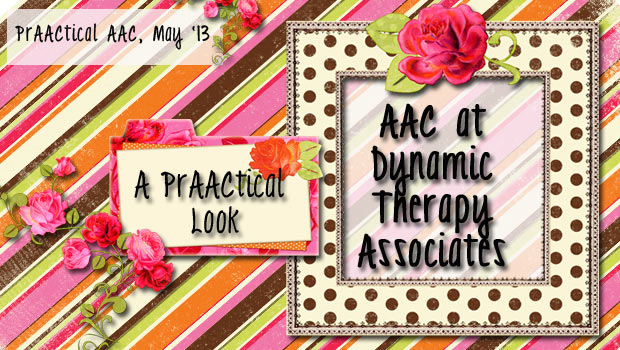
We’re so excited to continue our PrAACtical Look series with a guest post from Vicki Clarke, who is the CEO of Dynamic Therapy Associates, a speech language therapy clinic in Kennesaw, Georgia. Vicki specializes in AAC, conducting local and national device evaluations, consultations, treatments and trainings for individuals, clinics, school systems and professional organizations and manufacturers. Vicki has a wealth of knowledge in the prAACtical aspect of AAC service provision and shares a tiny bit of that with us in this post about preparing clients who use AAC for medical encounters. :::::::::::::::::::::::::::::::::::::::::::::::::::::::::::::::::::::::::::::::::::::::::::::::::::: I was asked to contribute a “favorite therapy activity” kind of post to this blog a few months ago. Decisions, decisions, decisions….I love Arts & Crafts Therapy, Cooking Therapy, iPad Therapy, Shopping Therapy, and Hang-Around-And-Chat Therapy but what to share? I mulled it over and I decided on “Serious Medical Procedure Preparation Therapy.” Fun stuff, right?!!? We do a lot... [Read More...]
May 2, 2013
by Carole Zangari -
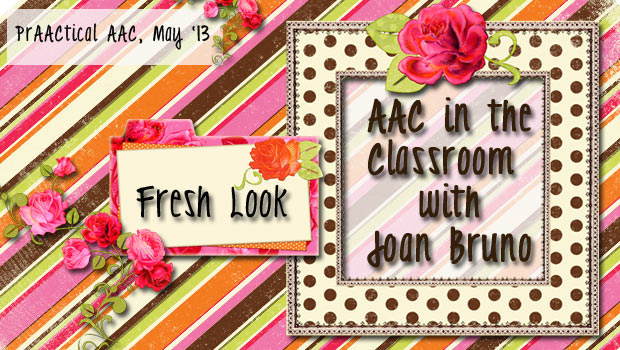
We’re off to a great start for Better Hearing and Speech Month! Today’s Fresh Look post comes from one of the most experienced AAC SLPs in the United States. Joan Bruno, Ph.D., CCC-SLP has over 30 years experience working in the field of AAC. She is currently maintains a private practice consulting to schools and private agencies and is the Augmentative Communication Specialist at the TECHConnection in Shrewsbury, NJ. Joan has published and presented nationally and internationally on a variety of topics related to AAC assessment and intervention. Joan is the 2011-2013 President of the New Jersey Speech and Hearing Association, and a Past-President of the United States Society for Augmentative and Alternative Communication. Since 1992, she has directed Camp Chatterbox, a therapy camp for children using AAC devices. Joan is the author of the Gateway to Language and Learning© page set and the Test of Aided-Communication Symbol Performance© (TASP). In... [Read More...]
April 23, 2013
by Carole Zangari -
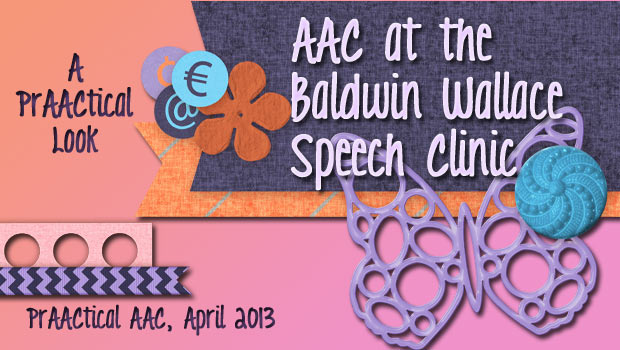
We’re always curious to know how other SLPs are running their AAC programs. When we got the idea for a series of posts highlighting schools and clinics that embrace AAC, we got excited. Welcome to “A PrAACtical Look”! In this series, we hope to introduce you to AAC programs around the world and give you a peek into what goes on in those practices. Hopefully, it will help strengthen connections in the AAC SLP community as we all get to know more about the ways in which our colleagues approach AAC assessment and intervention. There are many of you out there doing fine work with children and adults who use AAC. If you’d like to tell us about your AAC program, contact us through the blog or our Facebook page. We couldn’t be happier to start this series by introducing you to a place where undergraduate SLP students get hands-on... [Read More...]









